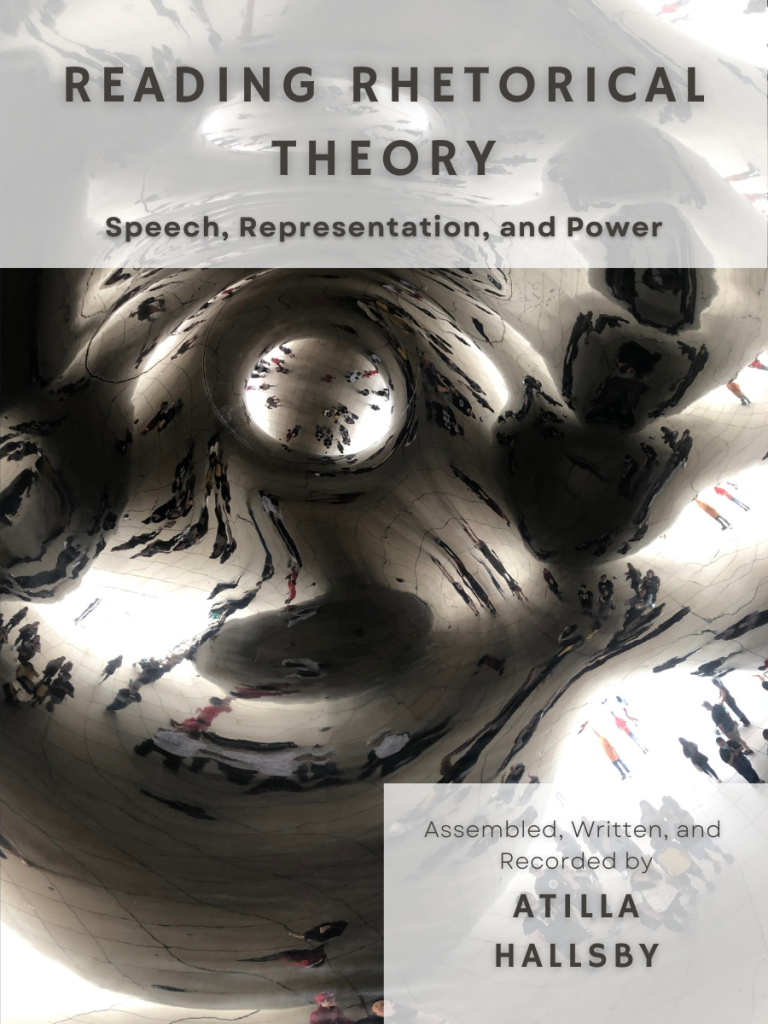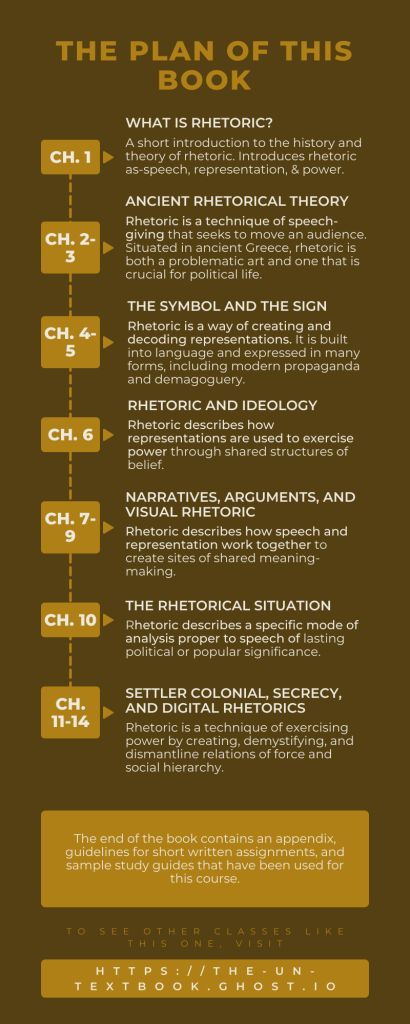Introduction
Atilla Hallsby

Why this Online Textbook?
With the onset of the COVID-19 global pandemic in Spring 2020, I began the process of transitioning course content from the in-person version of my large lecture, “Introduction to Rhetorical Theory,” to this platform. My intention was to create an accessible repository for teaching materials that would enable students to access the course remotely while minimizing the stress associated with this transition. After several semesters, I added recorded lectures, supplementary embedded videos, and guidance for written assignments. In its present form, the book now functions well for “flipped” modalities of teaching, both in-person and online. Given the significant labor cost associated with transitioning courses online, my hope was to (1) offload some of the effort of moving classes online by creating an open resource for other instructors to draw upon, (2) to provide a basis for instructors to justify the appropriateness of a rhetorical theory course for an online modality of teaching, and (3) to lighten the burden upon instructors and students at a time when online/in-person pivots are increasingly likely and unpredictable.
Reading Rhetorical Theory also provides a number of additional advantages over a conventional textbook.
- There is no cost to either the instructor or the student.
- It enables instructors to teach in a range of modalities, or to move between online and in-person administration as needed.
- It is formatted for reading/watching/listening on mobile devices and computers.
- The online format allows course content to be updated on the go, rather than releasing successive editions over time.
- Chapters/entries offer multiple ways for students to receive the materials. The written chapters contain the same content as the posted recorded lectures (although occasionally, the recordings will be truncated (i.e., shortened) compared to material posted in the textbook to avoid excessively long lectures).
- It provides a course shell that harmonizes with an ever-present need for online teaching in synchronous and asynchronous modalities while minimizing the amount of preparation required to teach.
Exam and quiz questions are currently available to confirmed course instructors on an individual basis. If you wish to access assessment questions, contribute to this resource, supply correction notices for content and/or broken links, or otherwise have feedback or requests regarding Reading Rhetorical Theory, please feel free to send a message to me using the email address listed at the bottom of this page. To avoid confusion while reading, please note! There is no chapter 13 in this book. Instead, Reading Rhetorical Theory skips from chapter 12 to chapter 14.
Why Speech, Representation, and Power?
When it is traced to Greek and Western European roots, the academic tradition of rhetorical studies is often divided into two categories, which correspond with its evolution as a tradition of higher learning: Rhetorica Docens and Rhetorica Utens. Rhetorica Docens is rhetoric as theory. Of the two, it is the earlier-occurring category and refers to an art (techne) of speech, spectacle, and fabrication governed by specific rules. This art is prescriptive in nature, in the sense that it offers guidelines for how speech can and should be organized and delivered. Frequently associated with the sophist Gorgias, the tradition of artful speaking diminished in importance between the 7th and the 15th centuries CE, displaced by the traditions of logic and dialectic. Rhetorica Utens is rhetoric as practice. Associated with Isocrates, it is a method of civic discourse that attends to the potential (dynamis) of speech and its enactment (praxis). It is a political process that organizes a population, guiding them toward prudent actions in the face of uncertain decisions.
As concerns Rhetorica Docens and Rhetorica Utens, this book is about rhetoric as theory AND as practice. Per the title, I expand upon these themes by offering three core understandings of rhetoric that progressively unfold over the chapters: Rhetoric as speech, Rhetoric as representation, and Rhetoric as power.
- Rhetoric as an art of speech is often the most familiar form of rhetoric for undergraduate students. They frequently encounter rhetoric as a systematic account of how to deliver genre-defined oratory in public speaking and argumentation classes. Here, rhetoric is about speech insofar as it concerns the practice of suasive speaking and writing, the artistic proofs (ethos, pathos, and logos) employed by a given speaker, as well as the political consequences of speaking that are hard-wired into rhetoric’s suite of theories. Speech describes a mode of translating thought into action, of imagining the disposition of those spoken-to or spoken-about, and vigilantly attending to the ethical consequences of speaking in public.
- Rhetoric as an art of representation expands upon speech by taking into account signs and symbols as vehicles for communication and persuasion. Representation requires a similar craft as spoken rhetoric insofar as signs and symbols are designed with an audience in mind. However, these audiences are often more sprawling and less easily defined than a physical audience, or people gathered in proximity to a single speaker. It also requires a different kind of literacy from audiences who regularly encounter signs and symbols because representations create an ideological matrix of belief and action. Representations are working upon us even when they do not appear to be doing anything at all; they describe ways of shaping the world, bringing forth thought and action at the level of the collective, the mass public, and the nation.
- Rhetoric as a technology of power describes the way that communication, persuasion, speech, and representation work in tandem to create and dismantle a “natural” conception of lived reality. Rhetoric makes and unmakes social and symbolic hierarchies; it attunes us to (incorrectly) believe that social stratification is normal or natural and provides an available means of undermining the social hierarchies that have become entrenched parts of lived experience. As a technology of power, rhetoric alerts us to the fact that our experiences speech, representation, and force are vastly different from one another. My familiar way of understanding and navigating this world cannot be generalized. It is habituated, made familiar by systems that are beyond perception but not beyond change. Power varies vastly depending on our experience in this nation or in others depending, for instance, on one’s position relative to the history of colonization, human enslavement, and imperialism. Because power is distinct within different cultures, under different forms of governance, and within distinct racial and gendered regimes, rhetoric can help us to understand how power acquires the feel of being ‘natural’ or ‘normal’ and how a shift in speaking and action can recalibrate these force relations.

The plan of this book moves from rhetoric as an art of speech to rhetoric as a technology of power. The early chapters provide definitions and context for rhetoric as speech, middle chapters (e.g., on signs, symbols, visual images, argumentation, and narrative) describe rhetoric as representation, and the concluding chapters (e.g., on settler colonialism, secrecy, and digital rhetoric) elaborate on rhetoric as a technology of power. Of course, there is considerable overlap across these areas: the chapter on “rhetoric and ideology” sets the stage for later understandings of rhetoric as power; the chapter on “the rhetorical situation” hearkens back to the introductory understanding of rhetoric as speech. Additionally, there is only so much time in a semester and only so much ground a course can cover. Even so, my hope is to update and expand these chapters and to invite others to contribute their unique work and necessary perspective to the tentative foundation that has been laid here. This and related courses are available to peruse at the companion website to this Online Textbook. If you are an instructor or student who wishes to contribute to the resource, please do not hesitate to reach out at the email address provided below.
As a final note, although each chapter also includes a note on how to cite this book, I strongly encourage students to cite the linked sources within the text itself. One example is the term “persona,” which has a long scholarly history in rhetorical studies. Many of the folks who have contributed to this conversation are cited if not also hyperlinked within this book. The same goes for any number of other concepts. Please cite those original sources when possible! A key affordance of a resource like this one is that it makes a wide selection of scholarship readily available to students and instructors. These ideas are not my inventions: they are the intellectual yield of hundreds of rhetoricians, accumulated over many, many, many years. Rhetorical theory is not a finished project and our work here is ongoing. In the meanwhile, however, I wish you all the best in your teaching and learning.
Thank you for picking up this book!
I hope that it is engaging and useful. If you have feedback, we have also set up this survey for you to let us know what’s working and what needs additional care.
Dr. Atilla Hallsby
RhetoricalTheoryUnTextbook@gmail.com
www.atillahallsby.com

